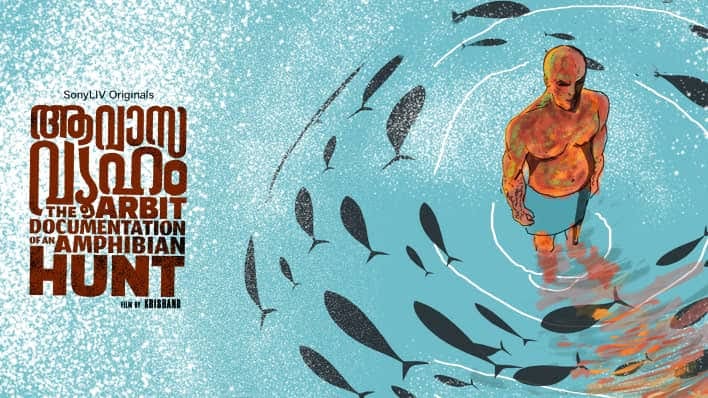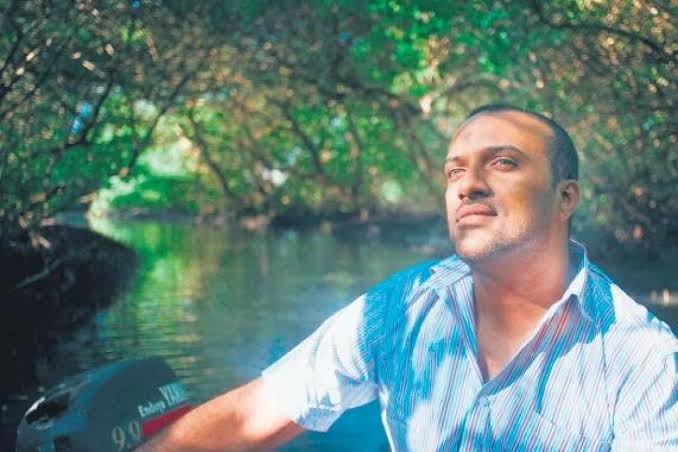
Krishand’s new film, “Aavasavyuham: The Arbit Documentation Of An Amphibian Hunt”, is now showing on Sonyliv and was premiered at the 26th International Film Festival of Kerala. It went on to win the FIPRESCI and NETPAC Awards for Best Malayalam Film at the festival. The film is spatially set in the coastal premises of Cochin, including Azhikode and Puthuvyp. The time period it depicts is also relatively contemporary. It is said that the film was made in the form of a mockumentary, along with enticing experiments, both form-wise and content-wise, that blur the conventional formal boundaries.
This note is not a proper review of the film per se, as many such accounts have already come out through various media platforms by applauding the film for the way in which it has been conceived and articulated. Rather, this note attempts to make a few random observations on how the film deals with some fundamental yet crucial aspects of human being as such.
Seeing Aavasavyuham
The ‘Other’ is a crucial philosophical concept or idea we often encounter in contemporary political scenarios. We usually consider/associate the ‘Other’ as/with ‘unknown’. But staying within the realm of modern security states, we are compelled to perceive the ‘Other’ as a potential threat who will take away our safety and security. Thus, this right-wing conception of other prepares us to exclude the ‘other’ in various forms, including legal measures by declaring them as ‘illegal’ or using security measures and annihilating them in various forms of ‘encounters’, latent and manifest.
In this cinema, the character played by Rahul Rajagopal is given the name of ‘Joy’. His character doesn’t have any particular spatial-temporal locations within the boundaries of the modern nation-state. He is perceived as an Other who doesn’t have any whereabouts and, therefore, an empty signifier on which any accusations of antagonistic and threatening can fall. Various people have different opinions about his origins, identities (always multiple and suspicious) and affinities.
His character is reconstructed through the narrations of various people whom he has encountered in his life. The way this very reconstruction is made possible is through narrations. These narrations are formally included in the manner of interviews, or more like a documentary setting. The reliability of these narrations is contested as the various versions of narrations often contradict. The constant blurring of the natural/fictional as a cinematic technique is effectively used as the cinematic truth doesn’t always fall synonymous with the absolute truth.


Various spatial contestations involving the state as an actor are also a part of the narration. These contestations, whether in the form of the IOC plant, show us how the coastal spaces are often considered marginal spaces that can be often violated and invaded. Along with that, we could see that Joy’s precarious/marginal identity is vulnerable to various modes and forms of violence, both initiated and collaborated by the state. The coastal geographical setting is also important as the narrative deals with the liminal, marginal forms of life, lying grey between black and white.
Hearing Aavasavyuham
The question of space and time is one of the significant questions surrounding cinema. Regarding time, Deleuze understands cinema ‘as industrial art achieves self-movement, automatic movement’ which ‘makes movement the immediate given of the image’. But at the same time, we should realise that cinema is not just the transparent projection of moving images occurring in a vacuum. It is also important to note that Cinema is not just another artistic format but a ubiquitous medium capitalizing upon multiple sensual realms to create a virtual reality. ‘Aavasavyuham’ embodies this multiplicity in its cinematic narrative. The moving images of various kinds of flora and fauna, along with their distinct and detailed sound, decenter the human-centric imaginations of space and sound. It occupies much space and frame in the movie and even leads the narration of the cinema.
Joy can produce certain specific sounds that are alien to other human counterparts but very effective in attracting various kinds of species, including frogs and fishes. The movie asks us to ‘open and re-quicken our ears’, as scholars like R. Murray Schafer and Lucian Febrve urge us to do. In the movie, various characters also talk about the smell of Joy’s body, which some call as stinking and pungent. The character of Joy is thus sensorial-ly constructed through embodying different forms of senses by shifting away from the bias of ocular-centrism, which often favours the prejudices inscribed in the bodies and minds of the observer.
Sensing Aavasavyuham
The film also calls for an understanding of life as something not just confined to humans but rather as an entanglement of our engagements with other kinds of living selves. The cinema helps us remember that scholars like Donna Haraway often remind us that the other species are “not here just to think with”; rather, they “are here to live with”. As the question of climate emergency knocks on our door more strongly than ever before, the cinema calls for an understanding that tries to de-center humans as the ultimate point of reference and imagination of cultural-social debates and urges us to look into the larger realities of complex entanglements of life webs which we are part of and live in. The title, Aavasavyuham itself reminds us of the complex entanglements of ecology. At the times of such emergencies, whose lives are more precarious and bare than the lives of ‘Others’, who are leading their lives without any identitarian markers and authorization by the sovereign powers or secular states? Thus, the cinema urges us to look into the Others, listen to them and thereby transform our own understanding of ourselves, needs and greed. At this point, ‘Prappeda’ and ‘Chavittu’, two films also can be clubbed together to sense this concern for the Other at the time of a humanitarian point of crisis where this very concern is considered the highest form of virtue a human can exhibit. This language of humanity is ‘always for the other, from the other, kept by the other, Coming from the other, remaining with the other, and returning to the other’, as Jaques Derrida rightly observes. Thus, Aavasavyuham demands us to re-fashion our senses and sensibilities and remains a call for humanity at the time of a crisis.



